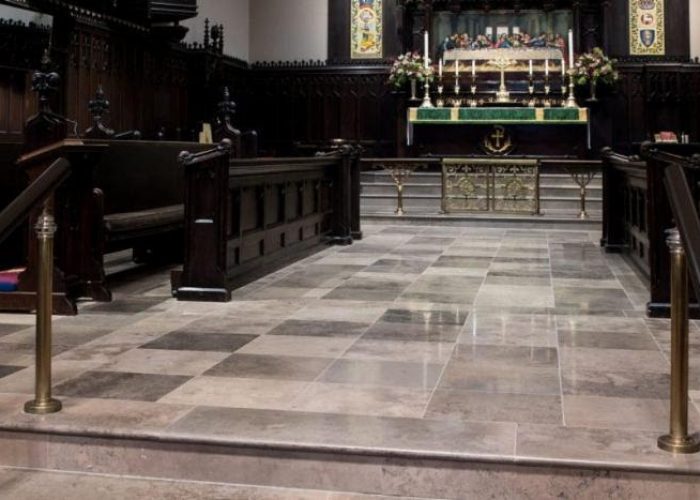
Beautiful Indiana Limestone Company Floors Highlight Renovation of Landmark Memphis Church
|
Bloomington, Ind., March 7, 2018 – Highlighting an impressive renovation at Grace-St. Luke’s Episcopal Church, a Memphis landmark, is a breathtaking floor constructed of native stone quarried by the Indiana Limestone Company. The Bloomington firm has been a leading supplier of architectural stone for nearly a century. Hord Architects of Memphis, a firm specializing in churches/ecclesiastical architecture and private schools, handled the project. Consultant Terry Byrd Eason assisted, chosen for his focus on Episcopal church liturgy. Distinguished by its strength and the beauty of its variegated colors and patterns, the stone is a blue-grey “driftstone” with intermixed buff accents. This rare stone is called Mavise, and is available only from a limited, exclusive deposit in the Indiana Limestone Company quarries. It was laid with its orientation directing a congregant’s movement forward through the narthex. The pattern and shape of the stone for the baptismal font is a centralized pattern with the font in the middle. Chancel stone reinforced the central aisle leading up to the altar. Father Richard Lawson of Grace-St. Luke’s called the overall project “the perfect combination of deferred maintenance and dreams.” The church’s mechanical systems were at the end of their life cycles, the space did not perform well acoustically, interior finishes needed updating and the cherished Tiffany Ascension stained glass window frame was due for structural reconstruction. Selective demolition occurred throughout the church proper. The chancel floor was stripped back to the concrete substrate, stairs were removed, the nave floor was demolished at the baptismal font, the narthex ceramic tile and ceiling were removed, and the Ascension window was removed for restoration. In addition, the balcony floor was demolished, the entire nave and transept ceiling was removed, and selective demolition was carried out to the sacristy, exterior and interior masonry. To support the added weight of stone, the concrete chancel floor received a structural beam and columns. A new concrete footing and stem wall support the baptistry plinth (or base). The beam was placed at the centerline of the elevated concrete slab. Leveling concrete was applied to the concrete slab in the chancel and narthex. A built-up plinth for the altar was constructed of light-gauge framing and structural lightweight concrete panels to support the stone beneath the altar. Indiana Limestone Company provided the raw block to Tennessee Marble Co. in Friendsville, for custom fabrication. Three-quarter inch stone tiles of various widths and lengths form the chancel floor, baptismal pedestal and the narthex floor. One-and-one quarter-inch stone treads were used on the chancel steps. According to the architectural firm, extensive programming meetings with a select building committee and the church rector helped define project goals and objectives. From these meetings emerged a ‘recipe’ to develop design intentions and the church’s aesthetic aspirations. Mr. Eason provided recommendations on design elements to meet aesthetic and liturgical goals of the church. Merck & Hill Consultants, Inc., Atlanta, provided programming meetings and spatial analysis to optimize acoustics in the space. OGCB, Inc. of Memphis provided outstanding HVAC and lighting design. Preconstruction and construction services from Montgomery Martin Contractors, Memphis, included advice on budget estimates, sequencing, schedule and constructability.
“Every goal,” said a spokesperson for Hord Architects, “was met, and the vestry and congregation were extremely pleased with the design process, the ensuing teamwork and the final results. The limestone is clearly a major success factor to the renovation project. Its beauty and durability provide meaning and permanence to the space. These are valuable attributes in ecclesiastic architecture.” Find more on Indiana Limestone Company and its products at www.indianalimestonecompany.co
|
Go Back




